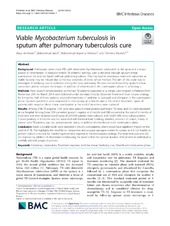| dc.contributor.author | Ambreen, Atiqa | en_US |
| dc.contributor.author | Jamil, Muhammad | en_US |
| dc.contributor.author | Rahman, Mohammad Aqeel Ur | en_US |
| dc.contributor.author | Mustafa, Tehmina | en_US |
| dc.date.accessioned | 2020-08-03T12:33:34Z | |
| dc.date.available | 2020-08-03T12:33:34Z | |
| dc.date.issued | 2019 | |
| dc.Published | Ambreen A, Jamil M, Rahman, Mustafa T. Viable Mycobacterium tuberculosis in sputum after pulmonary tuberculosis cure. BMC Infectious Diseases. 2019;19:923 | eng |
| dc.identifier.issn | 1471-2334 | |
| dc.identifier.uri | https://hdl.handle.net/1956/23365 | |
| dc.description.abstract | Background: Pulmonary tuberculosis (TB) with detectable Mycobacterium tuberculosis in the sputum is a major source of transmission. In resource limited TB endemic settings, cure is declared through sputum smear examination for acid fast bacilli without performing culture. This may lead to erroneous treatment outcomes as viable bacteria may be missed due to the low sensitivity of direct smear method. The aim of this study was to investigate if sterilizing cure is achieved among the new pulmonary TB cases declared cured by sputum smear conversion and to evaluate the impact of addition of ethambutol in the continuation phase in achieving it. Methods: New sputum smear-positive pulmonary TB patients registered at a tertiary care hospital in Pakistan from November 2013 to March 2014 were followed under standard Directly Observed Treatment Short Course strategy for 6 months. Half of these patients received ethambutol in addition to isoniazid and rifampicin in the continuation phase. Sputum specimens were examined on microscopy at 2 months and at the end of treatment. Sputa of patients with negative direct smear examination at the end of treatment were cultured. Results: Among 5746 TB suspects, 1595 were new sputum smear positive pulmonary TB cases, and 533 were registered at our hospital. Among these, 504 converted sputum negative at 2 months and 348 converted at the end of 6 months of treatment and were declared cured. Sputa of 204/348 patients were cultured, and 12/204 (6%) were culture-positive. Culture positivity at 6 months was not associated with bacterial load, smoking, diabetes, presence of cavities, history of contact with TB patients, age, sex, socioeconomic status, or addition of ethambutol in the continuation phase. Conclusion: Viable cultivable bacilli were detected in 6% of cured patients, which would have significant impact on the control of TB. This highlights the need for an inexpensive and accurate surrogate marker for culture as it is not feasible to perform culture in routine for monitoring treatment response in the low-resource settings. The treatment outcome did not improve by addition of ethambutol emphasizing the need to find the optimal duration of treatment for individual or carefully selected groups of patients. | en_US |
| dc.language.iso | eng | eng |
| dc.publisher | BioMed Central | eng |
| dc.rights | Attribution CC BY | eng |
| dc.rights.uri | http://creativecommons.org/licenses/by/4.0 | eng |
| dc.title | Viable Mycobacterium tuberculosis in sputum after pulmonary tuberculosis cure | en_US |
| dc.type | Peer reviewed | |
| dc.type | Journal article | |
| dc.date.updated | 2020-01-21T18:41:52Z | |
| dc.description.version | publishedVersion | en_US |
| dc.rights.holder | Copyright 2019 The Author(s) | |
| dc.identifier.doi | https://doi.org/10.1186/s12879-019-4561-7 | |
| dc.identifier.cristin | 1758702 | |
| dc.source.journal | BMC Infectious Diseases | |

